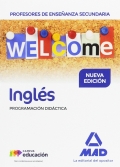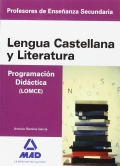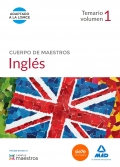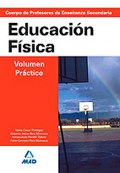Tienda > Libros > Escuela > Temarios de oposiciones y formación profesional > Ingles
- Cuadernos para adultos
- Educación
- Educación artística
- Educación especial/NEE
- Educación física
- Diccionarios
- Escuela
- Estimulación precoz
- Guías para padres
- Infantil y juvenil
- Libros de juegos y actividades
- Lingüística
- Logopedia
- Pedagogía
- Pruebas y protocolos
- Psicología
- Refuerzo escolar
- Salud
- Sociología
- Temas de autoayuda
- Terapias complementarias
- Tercera edad
- Promociones
REGISTRO
Inglés. Programación Didáctica. Cuerpo de Profesores de Enseñanza Secundaria.
Temarios Mad
The book is divided into 3 main parts:
The first includes some general considerations to be taken into account when designing the Syllabus for English (the Foundations). For this part the main sources have been the "Common European Framework for Languages", various articles from the Internet TESL Journal and from ERIC (Education Resources Information Centre, of the US Department of Education).
The second part (some Guidelines) aims to give candidates exactly that, some guidelines to follow when planning their syllabus, units and teaching sessions for ESO.
Finally, the third part includes 2 examples of syllabus design, one for 1st of ESO, the other one for 4th of ESO. These two examples are just that, examples for a specific area, a specific school and a specific class, taking into account what has been said under "the Foundations" and following "some Guidelines" in the second part.
The aim is to give candidates and Secondary English teachers in general ideas on how to organise their syllabus design and the planning of their didactic units.
Syllabus Design: The Foundations
1. The subject of our syllabus
1.1. Implications of teenagers’ physical, cognitive & psychological development
1.2. Motivations, expectations & needs
2. The Statutory Scope
2.1. Education Principles
2.2. General aims for Compulsory Secondary Education
2.3. General objectives for CSE (ESO)
2.4. General objectives for the teaching of modern languages at CSE
3. The school documents
3.1. The school environment
3.2. The students
3.3. The resources & plans to cater for diversity
4. Methodological approaches to language teaching
4.1. Introduction
4.2. Approaches to Syllabus design
4.3. Integration of approaches & specification of goals and objectives
4.3.1. Integration of approaches
4.3.2. Specifications of goals and objectives in syllabus design
4.4. Competences and the role of tasks in language teaching
4.4.1. What the legal documents say on competences
4.4.2. Some Guidelines to develop competences
4.4.3. Dealing with errors and mistakes when developing competences
4.4.4. Tasks and their role in language teaching
4.5. The role of assessment in language teaching
4.5.1. Types of assessment
4.5.2. What the legal documents say on assessment
4.5.3. The place of assessment in the teaching process
4.5.4. Common types of assessment appropriate for the language class
4.6. Remedial work & catering for diversity
5. The Resources
5.1. Traditional means
5.2. Audio-visual means of education and approaches to video-production
5.3. Information and Communication Technologies (ICT)
6. The teacher’s role
Syllabus Design: Some guidelines
1. The bases for planning our syllabus
2. The context for teaching English in compulsory Secondary Education
3. Drawing-up the syllabus design
3.1. The rationale
3.1.1. Introduction
3.1.2. Reasons for planning
3.1.3. Composing a Syllabus
3.1.4. Practical guidelines to syllabus design
3.2. Unit planning
3.2.1. Unit and lesson
3.2.2. Elements in a unit
3.2.3. Hints & techniques for more balanced unit and lesson planning
3.2.4. Useful tips for lesson and unit planning
4. Recapitulation: essential elements in a Syllabus design
Syllabus Desing for CSE/ESO: Two samples
Example 1: A syllabus design for 1st year of cse (ESO)
1. The rationale behind this Syllabus Design
1.1. Documents
1.2. The context for teaching English in Compulsory Secondary Education
1.3. The school
1.4. The students
1.5. Methodology, resources (including ICT) and activities
1.5.1. Methodological approaches
1.5.2. Activities, interactions and general procedure
1.5.3. Materials, resources and ICT
1.5.4. Catering for diversity
1.5.5. Developing skills and communicative competences
2. Objectives
3. Timing
4. Contents
4.1. General Contents in the units
4.2. Unit Plans
5. Criteria for assessment & remedial work
Annex I. Example of Unit plan & Lesson Development for the 1st year of CSE (Unit 8)
Example 2: Syllabus design for 4th year of cse (eso)
1. The rationale behind this syllabus design
1.1. Documents
1.2. The School
1.3. The Students
1.4. Methodology, ICT & other resources and activities
2. Objectives
3. Criteria for assessment & remedial work
4. Contents, Timing & Planning
4.1. Common contents for all the units
4.2. Content organisation & timing: Unit Plans
Annex ii. Rationale behind unit 5 & unit development
Supplementary samples for activities, unit and lesson planning
Legislation
Bibliography
Editorial: Mad
ISBN: 9788414218372
Publicado:4/2017
Páginas: 268
Idioma: Inglés
Encuadernación: Rústica
DEL MISMO AUTOR
- Tecnología. Programación Didáctica y 15 Unidades Didácticas de 4º de ESO. Cuerpo de Profesores de Enseñanza Secundaria.
- Primaria. Secuencia de Unidades Didácticas Desarrolladas. Cuerpo de Maestros.
- Francés. Temario. Volumen 2. Cuerpo de Profesores de Enseñanza Secundaria.
- Organización y Procesos de Mantenimiento de Vehículos. Temario. Volumen I. Cuerpo de Profesores de Enseñanza Secundaria.
- Organización y Procesos de Mantenimiento de Vehículos. Temario. Volumen II. Cuerpo de Profesores de Enseñanza Secundaria.
- Organización y Procesos de Mantenimiento de Vehículos. Temario. Volumen III. Cuerpo de Profesores de Enseñanza Secundaria.
G R A T I S
TIENDA

-
El tema que nos ocupa es el de la Programación Didáctica y la elaboración de las Unidades Didácticas, cuya confección es para much...24.00 €
-
La publicación que presentamos tiene como objetivo ayudar y orientar a los maestros para su futuro ingreso en el Cuerpo de Maestro...35.00 €
-
Este volumen ofrece un generoso muestrario de problemas resueltos para Educación Física, aplicables a una gran variedad de situaci...40.50 €
-
En este libro intentamos resolver una serie de cuestiones prácticas que se le pueden plantear al opositor/a. La solución que propo...20.00 €


















